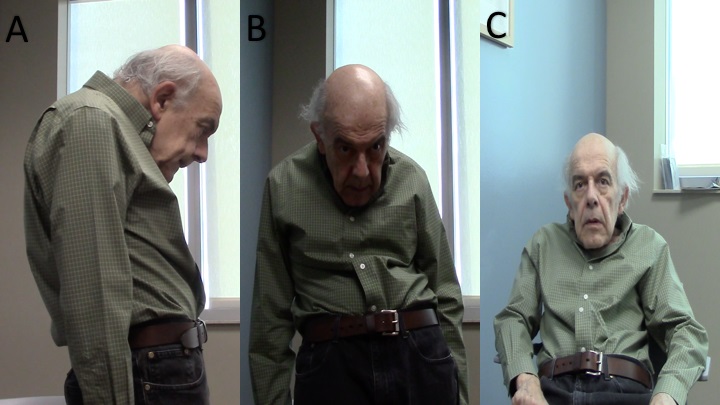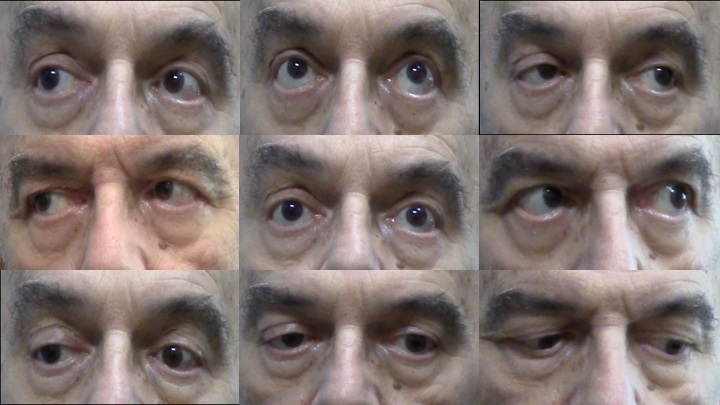Session Information
Date: Wednesday, June 7, 2017
Session Title: Phenomenology and Clinical Assessment Of Movement Disorders
Session Time: 1:15pm-2:45pm
Location: Exhibit Hall C
Objective: To describe an interesting case of new-onset diplopia due to loss of compensation for trochlear nerve palsy as a result of dropped head in the setting of Parkinson’s disease (PD).
Background: Dropped head syndrome can emerge within a diverse range of neuromuscular conditions including myopathies, motor neuron disease, and parkinsonism, most commonly multiple system atrophy (1). Incidence of dropped head syndrome in idiopathic PD is less than 6% in patients with H&Y 3, based on available data (2), and increases in risk with disease progression. Dropped head may cause pain, impaired balance, but to our knowledge has not been reported to provoke diplopia in a vulnerable patient.
Methods: Case Report
Results: A 71-year-old man with congenital well-compensated left trochlear nerve palsy developed idiopathic PD that presented with stooped posture and right-sided rigidity and rest tremor, and had a good and enduring levodopa response. Around 5 years into the course, he started developing subacute progression of forward flexion of the neck and later, double vision. His postural change was severe, and ultimately his chin touched his chest at rest (Figure 1). The dropped head was refractory to his dopaminergic therapy and had only partial response to physical therapy and botulinum toxin injections to bilateral sternocleidomastoid muscles. MRI neck demonstrated 2mm anterolisthesis at C6-7 but no other contributory findings. He reported that double vision would occur with two images in a V-shaped configuration. He relayed that he had been told he previously “shifted his horizon” to compensate, and his driver’s license demonstrated the prior right head tilt. Recently, he discovered that he could improve his double vision by slouching down in his chair and tilting his body to the right. Ophthalmologic evaluation revealed a left superior oblique palsy with 2-5 degrees of incyclotorsion on the right on double Maddox rod testing and left hypertropia (Figure 2). A Fresnel prism was prescribed to correct for his left hypertropia with only partial benefit.
Conclusions: This case highlights an interesting and unexpected consequence of dropped head syndrome in a man with formerly well-compensated congenital trochlear nerve palsy.
References: (1) Fujimoto K. Dropped head in Parkinson’s disease. J Neurol. 2006 Dec;253 Suppl 7:VII21-26. Review. PubMed PMID: 17131224 (2) Kashihara K, Imamura T. Clinical correlates of anterior and lateral flexion of the thoracolumbar spine and dropped head in patients with Parkinson’s disease. Parkinsonism Relat Disord. 2012 Mar;18(3):290-3. doi:10.1016/j.parkreldis.2011.11.012. PubMed PMID: 22119504.
To cite this abstract in AMA style:
W. Deeb, I. Malaty. Diplopia: An Interesting Complication of Dropped Head Syndrome [abstract]. Mov Disord. 2017; 32 (suppl 2). https://www.mdsabstracts.org/abstract/diplopia-an-interesting-complication-of-dropped-head-syndrome/. Accessed April 1, 2025.« Back to 2017 International Congress
MDS Abstracts - https://www.mdsabstracts.org/abstract/diplopia-an-interesting-complication-of-dropped-head-syndrome/


